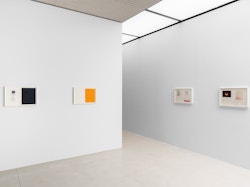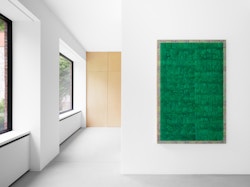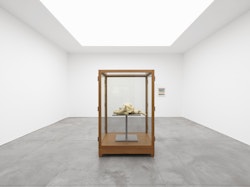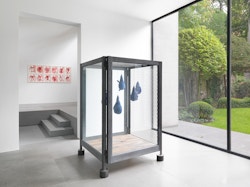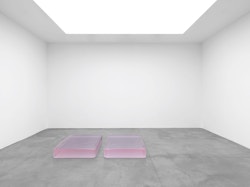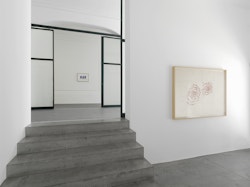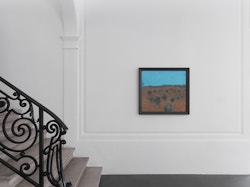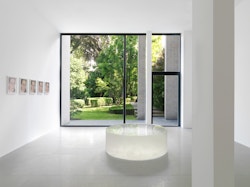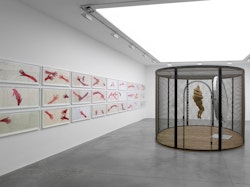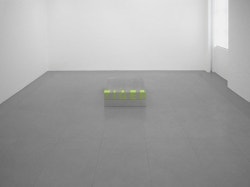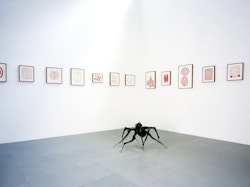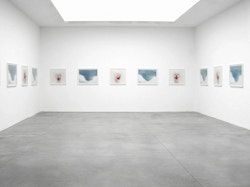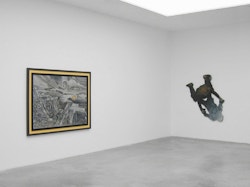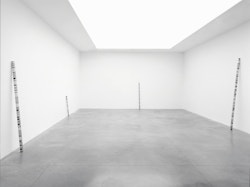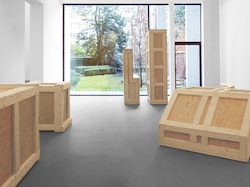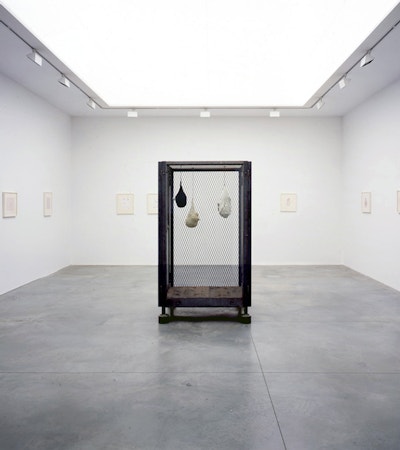
Richard Artschwager, Louise Bourgeois, Roni Horn, Allan McCollum
Richard Artschwager
EXCLAMATION POINT (AP), 1995, Nylon bristle, wood
“I would call this the ‘prince of punctuation’. Spiraling free but gravity-aware. Hopping on one foot… Can operate with respect to itself or anybody/thing around.” A function of the punctuation pieces that first appeared in 1966 was to frame space in the same way an Exclamation Point or Quotation Mark frames speech. Similar attempts to disrupt patterns of seeing and reading occurred throughout the sixties as exemplified by the contemporary renaissance of concrete poetry, and the publication of Notations (1968), a collection edited by John Cage of new music notation which ranged from erratic angles, to creepy drips to simple language. Artschwager’s punctuation pieces performed a rhetoric of seeing using familiar grammar, turning their surroundings into floating concrete poems. Bristle is one of Artschwager’s favorite materials: he uses it in the ‘Punctuation Pieces’, the boxes the blps and in the more recent ‘Shadow Pieces’. The material is sensual, tactile and its vague, tickling contours remind him of is own myopia. Artschwager calls his bristle pieces ‘Myopic Constructions’, a description that characterizes the poetic approach and joyful humor of his work in general.
Louise Bourgeois
CELL XIX (Portrait), 2000, steel, fabric, wood and glass
“Sculpture allows me to re-experience the past in its objective, realistic proportion. Since the fears of the past were connected with the functions of the body, they reappear through the body. For my sculpture is the body. My body is my sculpture.” Decades on, this statement has reached its apotheosis in a series of oddly compelling sculptures constructed from the contents of Louise Bourgeois’s closet. The closet is just one of her many, assiduously maintained personal inventories. She keeps track of the culture of her life – material, metaphysical, emotional and philosophical – which spans nearly the whole of the 20th-century… In editing her wardrobe and personal effects thus, she has provided with some of the most poignant sculptures of her oeuvre, at once hermetic and communicative, fragile and potent. In some instances the clothes are left whole, in others they are recut and worked into phantasms, fanciful costumes or primordial Mephistophelian creatures; in others still, the clothes are sewn together and filled to suggest dismembered partial bodies. Clothes present themselves both as anatomical diagrams and as living memories. “For me, fashion is constructed, it is a context, a personal experience. It is not a concept. It is a repeated experience. It is a semiological system… For me, fashion is the experience of living in this garment, in this pair of shoes. It is a three-dimensional experience.”
Roni Horn
ASPHERE, 1986 – 1995, Solid steel sphere, disorted slightly and in varying degree in each hemisphere
In the Timaeus, Plato wrote that the sphere is the most perfect and uniform figure, for all points of its surface are equidistant from its center. Through the ages the sphere had religious significance. Alain de Lille, a French theologian of the twelfth century, discovered a text attributed to Hermes Tirsmegistus from the Asclepius which stated “God is an intelligible sphere whose center is everywhere and whose circumference is nowhere”. Blaise Pascal wrote: ‘Nature is an infinite sphere whose center is everywhere and whose circumference is nowhere’. Roni Horn’s ASPHERE is a self-portrait, an abstract embodiment of how she insinuates her presence in the world. The ASPHERE is an industrially produced, solid copper or steel sphere that has been slightly distorted. This distortion results in a form that looks like a sphere but does not behave like one. Initially ASPHERE appears to center, but the actual experience of it does not. A form so apparently familiar becomes less familiar the more time you spend with it. Dissatisfaction sets in as ASPHERE refuses to perform according to your expectations. In other words, it ‘disappoints’.
Allan McCollum
240 SMALL PLASTER SURROGATES, 1988, enamel on hydrostone
“The motivation behind making the Surrogate Paintings was to represent something: to represent the way a painting ‘sits’ in a system of objects. Look at installation shots, or pictures taken of art galleries – that was the picture I had in mind. I was trying to reproduce that picture of an art gallery in three dimensions, a tableau. So with the Surrogate Paintings the goal was to make them function as ‘props’ so that the gallery itself would become like a picture of a gallery by re-creating an art gallery as a stage set. To me this was a clear representation of the way paintings looked in the world irrespective of whether there’s a ‘representation’ within the painting or not. Also there was a kind of theatrical motivation, maybe a Brechtian motivation, in which I wanted the viewer to be self-consciously caught up in the act of wanting to see a picture. So in a sense the emotional content of these ‘surrogate paintings’ involved the desire to look at a picture. I was trying to trigger that desire by reproducing that entire tableau within which the viewer would be aroused to desire a picture, but at the same time not fulfilling that desire so that, again, the viewer would be caught in the act of experiencing this desire.”
